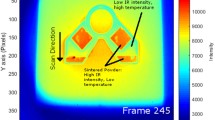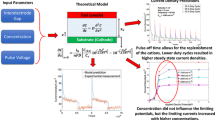Abstract
Non-uniformity in electrode thickness can result in quality control defectively. To quantitatively detect the non-uniformity of electrode thickness during the manufacturing processes. A heat transfer model based on heat conduction equation has been employed to provide the computational study. The effects of boundary conditions of adiabatic and periodic walls along coating direction, electrode thickness changes from 3.9 to 30.0 %, and two types of located region in thickness changes, as well as anode and cathode material properties on temperature change percents are analyzed and discussed in detail. The relationship between thickness changes percents and temperature change percents of electrode is established. It is found that the thickness changes have a sensitivity of 1 % changes in electrode thickness will result in 1 % in temperature changes at an inherent time point. The selected time points are 0.008 or 0.01 s for cathode and 0.004 s for anode. The minimum thickness change percent 3.9 % will be detected. Further, the comparison of the computational results with experimental ones shows the validity of the heat conduction model.









Similar content being viewed by others
References
de las Casas C, Li W (2012) A review of application of carbon nanotubes for lithium ion battery anode material. J Power Sources 208:74–85
Ji L, Lin Z, Alcoutlabi M, Zhang X (2011) Recent developments in nanostructured anode materials for rechargeable lithium-ion. Energy Environ Sci 4:2682–2699
Anonymous (2002) FreedomCAR 42 V energy storage system end-of-life performance goals. USABC, Southfield. http://www.uscar.org/guest/view_team.php?teams_id=12
Maldague X (2002) Introduction to NDT by active infrared thermography. Electrical and Computing Engineering Department, Universite Laval, Quebec City, Canada
Maldague X (2001) Theory and practice of infrared technology for nondestructive testing. Wiley-Interscience, New York
Sakagami T, Kubo S (2002) Applications of pulse heating thermography and lock-in thermography to quantitative nondestructive evaluations. Infrared Phys Technol 43:211–218
Inagaki T, Ishii T, Iwamoto T (1999) On the NDT and E for the diagnosis of defects using infrared thermography. NDT & E Int 32:247–257
Perkowski Z (2011) A thermal diffusivity determination method using thermography: theoretical background and verification. Int J Heat Mass Transf 54:2126–2135
Huda ASN, Taib S (2013) Application of infrared thermography for predictive/preventive maintenance of thermal defect in electrical equipment. Appl Therm Eng 61:220–227
Jadin MS, Taib S, Ghazali KH (2015) Finding region of interest in the infrared image of electrode installation. Infrared Phys Technol 71:329–338
Artozoul J, Lescalier C, Bomont O, Dudzinski D (2014) Extended infrared thermography applied to orthogonal cutting: mechanical and thermal aspects. Appl Therm Eng 64:441–452
Valiorgue F, Brosse A, Naisson P, Rech J, Hamdi H, Bergheau JM (2013) Emissivity calibration for temperatures measurement using thermography in the context of machining. Appl Therm Eng 58:321–326
Garavand AT, Ahmadi H, Omid M, Mohtasebi SS, Mollazade K, Smith AJR, Carlomagno GM (2015) An intelligent approach for cooling radiator fault diagnosis based on infrared thermal image processing technique. Appl Therm Eng 87:434–443
Carlson J, Menicucci D, Vorobieff P, Mammoli A, He H (2014) Infrared imaging method for flyby assessment of solar thermal panel operation in filed settings. Appl Therm Eng 70:163–171
Vavilov VP (2014) Modeling thermal NDT problems. Int J Heat Mass Transf 72:75–86
Li H, Hrnjak P (2015) Quantification of liquid refrigerant distribution in parallel flow microchannel heat exchanger using infrared thermography. Appl Therm Eng 78:410–418
Karthikeyan VK, Khandekar S, Pillai BC, Sharma PK (2014) Infrared thermography of a pulsating heat pipe: flow regimes and multiple steady states. Appl Therm Eng 62:470–480
Ay H, Jang JY, Yeh J-N (2002) Local heat transfer measurements of plate finned-tube heat exchangers by infrared thermography. Int J Heat Mass Transf 45:4069–4078
Li H-Y, Chao S-M, Tsai G-L (2005) Thermal performance measurement of heat sinks with confined impinging jet by infrared thermography. Int J Heat Mass Transf 48:5368–5394
Freund S, Pautsch AG, Shedd TA, Kabelac S (2007) Local heat transfer coefficients in spray cooling systems measured with temperature oscillation IR thermography. Int J Heat Mass Transf 50:1953–1962
Sarraf K, Launay S, Achkar GE, Tadrist L (2015) Local vs global heat transfer and flow analysis of hydrocarbon complete condensation in plate heat exchanger based on infrared thermography. Int J Heat Mass Transf 90:878–893
Chauvet F, Cazin S, Duru P, Prat M (2010) Use of infrared thermography for the study of evaporation in a square capillary tube. Int J Heat Mass Transf 53:1808–1818
Saha A, Kumar R, Basu S (2010) Infrared thermography and numerical study of vaporization characteristics of pure and blended bio-fuel droplets. Int J Heat Mass Transf 53:3862–3873
Golobic I, Petkovsek J, Kenning DBR (2012) Bubble growth and horizontal coalescence in saturated pool boiling on a titanium foil, investigated by high-speed IR thermography. Int J Heat Mass Transf 55:1385–1402
Lewandowski WM, Ryms M, Denda H, Radziemska EK (2014) Possibility of thermal imaging use in studies of natural convection heat transfer on the example of an isothermal vertical plate. Int J Heat Mass Transf 78:1232–1242
Schreivogel P, Pfitzner M (2015) Optical convective heat transfer measurements using infrared thermography and frequency domain phosphor thermometry. Int J Heat Mass Transf 82:299–308
Chauris N, Ayel V, Bertin Y, Romestant C (2015) Evaporation of a liquid film deposited on a capillary heated tube: experimental analysis by infrared thermography of its thermal footprint. Int J Heat Mass Transf 86:492–507
Isakov DV (2015) Infrared detection of water ingress in a composite laminate crevice based on room temperature evaporation. Int J Heat Mass Transf 86:39–42
Vavilov VP, Burleigh DD (2015) Review of pulsed thermal NDT: physical principles, theory and data processing. NDT & E Int 73:28–52
Nagpure SC, Dinwiddie R, Babu SS, Rizzoni G, Bhushan B, Frech T (2010) Thermal diffusivity study of aged Li-ion batteries using flash method. J Power Sources 195:872–876
Wang Z, Li Z, Liu Q (2011) Infrared thermography non-destructive evaluation of lithium-ion battery. Proc SPIE 8193:819341-1–819341-8
Rhodes K, Kirkham M, Meisner R, Parish C, Dudney N, Daniel C (2011) Novel cell design for combined in situ acoustic emission and X-ray diffraction study during electrochemical cycling of batteries. Rev Sci Instrum 82:075107-1–075107-7
Sharp N (2012) Lithium-ion battery electrode inspection using flash thermography. Master Degree of Science in Mechanical Engineering, Dissertation, Prudue University, West Lafayette
Ye W-B (2016) Thermal simulation and evaluation for non-uniformity detection of electrode. Appl Therm Eng 96:583–592
Patankar SV (1980) Numerical heat transfer and fluid flow. McGraw Hill, New York
Versteeg HK, Malalasekera W (2007) An introduction to computational fluid dynamics—the finite volume method (2nd version). Pearson Education Limited, England
Author information
Authors and Affiliations
Corresponding author
Rights and permissions
About this article
Cite this article
Ye, WB. Finite volume analysis the thermal behavior of electrode non-uniformity. Heat Mass Transfer 53, 1123–1132 (2017). https://doi.org/10.1007/s00231-016-1879-1
Received:
Accepted:
Published:
Issue Date:
DOI: https://doi.org/10.1007/s00231-016-1879-1




